Fine Particulate Matter (PM2.5) Sources and Its Individual Contribution Estimation Using a Positive Matrix Factorization Model
Abstract
:1. Introduction
2. Materials and Methods
2.1. Research Period and Sampling Points
2.2. Sampling and Analysis
2.3. PMF Model
2.4. CPF Model
3. Results and Discussion
3.1. Source Classification and Identification through PMF Modeling
3.2. Quantitative Assessment of the Contribution of Each Pollution Source
3.3. Assessing PMF Model Reliability
3.4. Using CPF Modeling to Verify the Source Locations of Pollutants
4. Conclusions
Author Contributions
Funding
Institutional Review Board Statement
Informed Consent Statement
Data Availability Statement
Acknowledgments
Conflicts of Interest
References
- AirVisual. 2019 World Air Quality Report; AirVisual: Goldach, Switzerland, 2019. [Google Scholar]
- IQAir. 2020. Available online: https://www.iqair.com/ko/world-most-polluted-countries (accessed on 20 June 2021).
- Kim, E.J. Legislative Study for the Integrated Management of Air Pollutants; Korea Legislation Research Institute: Seoul, Republic of Korea, 2019; pp. 1–446. Available online: http://klri.re.kr:9090/handle/2017.oak/9157?mode=full (accessed on 29 January 2019).
- Russell, A.G.; Brunekreef, B. A Focus on Particulate Matter and Health. Environ. Sci. Technol. 2009, 43, 4620–4625. [Google Scholar] [CrossRef] [PubMed] [Green Version]
- Jo, J.H.; Kim, E.J. Analysis of Technology Market Trends Related to Indoor Fine Dust Removal; Korea Institute of Science and Technology Information: Daejeon, Republic of Korea, 2014; pp. 1–109. Available online: https://repository.kisti.re.kr/handle/10580/6571 (accessed on 31 December 2014).
- Zhao, W.; Hopke, P.K. Source apportionment for ambient particles in the San Gorgonio wilderness. Atmos. Environ. 2004, 38, 5901–5910. [Google Scholar] [CrossRef]
- Heo, J.; Kim, C.; Min, Y.; Kim, H.; Sung, Y.; Kim, J.; Lee, K.; Heo, J. Source Apportionment of PM10 at Pyeongtaek Area Using Positive Matrix Factorization (PMF) Model. J. Korean Soc. Atmos. Environ. 2018, 34, 849–864. [Google Scholar] [CrossRef]
- Bucheon. 2020. Available online: https://www.bucheon.go.kr/site/program/board/basicboard/list?boardtypeid=26716&menuid=148004003004 (accessed on 8 February 2021).
- Lee, K.-B.; Kim, S.-D.; Kim, D.-S. Ion Compositional Existence Forms of PM10 in Seoul Area. J. Korean Soc. Environ. Eng. 2015, 37, 197–203. [Google Scholar] [CrossRef] [Green Version]
- Lee, T.-J.; Huh, J.-B.; Yi, S.-M.; Kim, S.-D.; Kim, D.-S. Estimation of PM10 source contributions on three cities in the metropolitan area using the PMF model. J. Korean Soc. Atmos. Environ. 2009, 25, 275–288. [Google Scholar] [CrossRef] [Green Version]
- Nam, B.H. Pattern Classification of PM10 Sources and Their Mass Contributions to the Indoor Environment. Master’s Thesis, Kyunghee University, Yongin, Republic of Korea, 2001; pp. 1–77. [Google Scholar]
- Song, X.-H.; Polissar, A.V.; Hopke, P.K. Source of fine particle composition in the north eastern US. Atmos. Environ. 2001, 35, 5277–5286. [Google Scholar] [CrossRef]
- Begum, B.A.; Kim, E.; Biswas, S.K.; Hopke, P.K. Investigation of sources of atmospheric aerosol at urban and semi-urban areas in Bangladesh. Atmos. Environ. 2004, 38, 3025–3038. [Google Scholar] [CrossRef]
- Kim, E.; Hopke, P.K. Comparison between conditional probability function and nonparametric regression for fine particle source directions. Atmos. Environ. 2004, 38, 4667–4673. [Google Scholar] [CrossRef]
- Zhou, L.; Hopke, P.K.; Paatero, P.; Ondov, J.M.; Pancras, J.P.; Pekney, N.J.; Davidson, C.I. Advanced factor analysis for multiple time resolution aerosol composition data. Atmos. Environ. 2004, 38, 4909–4920. [Google Scholar] [CrossRef]
- Kim, E.; Hopke, P.K.; Edgerton, E.S. Source identification of Atlanta aerosol by positive matrix factorization. J. Air Waste Manag. Assoc. 2003, 53, 731–739. [Google Scholar] [CrossRef] [PubMed]
- Chow, J.C.; Liu, C.S.; Cassmassi, J.; Watson, J.G.; Lu, Z.; Pritchett, L.C. A neighborhood-scale study of PM10 source contributions in Rubidox, California. Atmos. Environ. Part A Gen. Top. 1992, 26, 693–706. [Google Scholar] [CrossRef]
- Chang, Y.S.; Carmichael, G.R.; Kurita, H.; Ueda, H. An investigation of the formation of ambient NH4NO3 aerosol. Atmos. Environ. 1986, 20, 1969–1977. [Google Scholar] [CrossRef]
- Shim, S.Y. Identification of Ambient PM2.5 Sources with PMF Receptor Model and Estimation of their Source Contribution in the Gwangju Area. Master’s Thesis, Chonnam National University, Gwangju, Republic of Korea, 2013; pp. 1–58. [Google Scholar]
- Hwang, I.J. Estimation of Quantitative Source Contribution of Ambient PM10 Using the PMF Model. Ph.D. Thesis, Kyunghee University, Yongin, Republic of Korea, 2003; pp. 1–228. [Google Scholar]
- Jeong, Y.J. Source Apportionment of PM2.5 in Gyeongsan Using Positive Matrix Factorization. Master’s Thesis, Daegu University, Gyeongsan, Republic of Korea, 2014; pp. 1–74. [Google Scholar]
- Park, M.B. PM2.5 Characterization and Source Apportionment based on Real-Time Seoul Monitoring Data by PMF Model. Master’s Thesis, Kyunghee University, Yongin, Republic of Korea, 2017; pp. 1–103. [Google Scholar]
- Oh, M.S. Quantitative Source Apportionment of Airborne Particulate Matter Using an 8-Stage Cascade Impactor in Suwon. Master’s Thesis, Kyunghee University, Yongin, Republic of Korea, 2008; pp. 1–132. [Google Scholar]
- Lee, G.H. Identification of pollution sources and estimated contribution of fine particulate matter (PM2.5) in the atmosphere using multivariate statistical analysis and PMF Model—Climate change adaption policy. Master’s Thesis, Kyunghee University, Yongin, Republic of Korea, 2021; pp. 1–130. [Google Scholar]

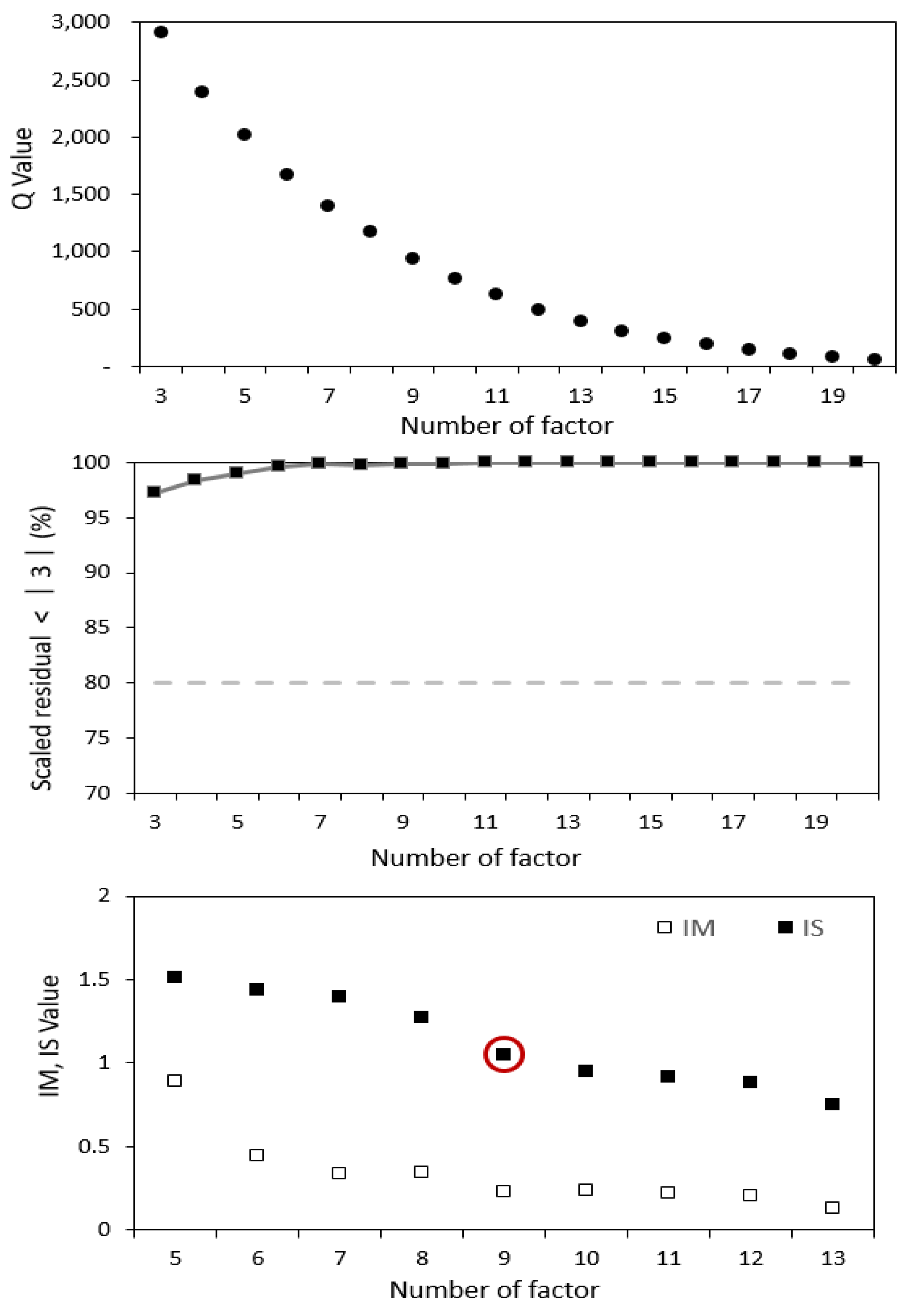
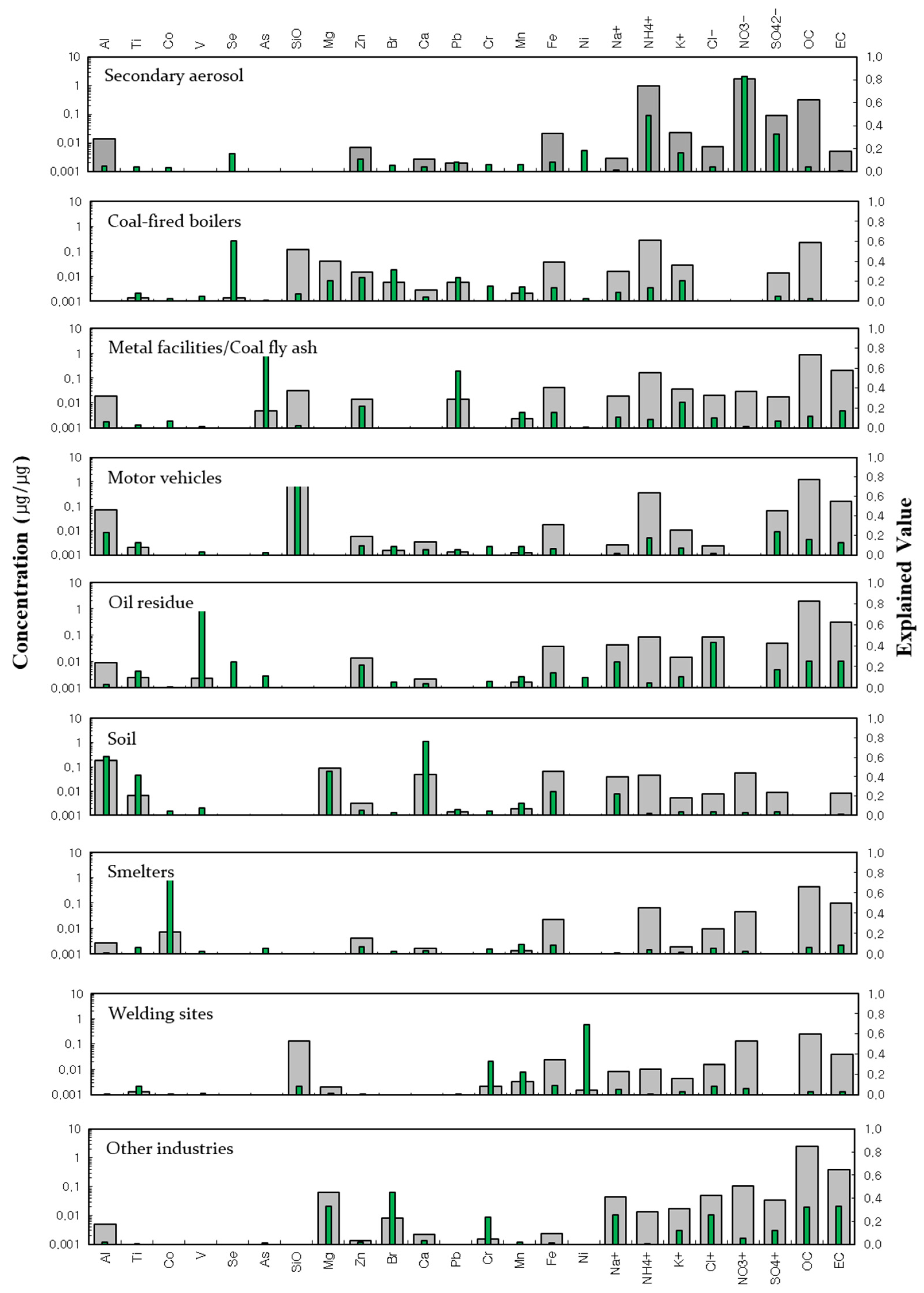
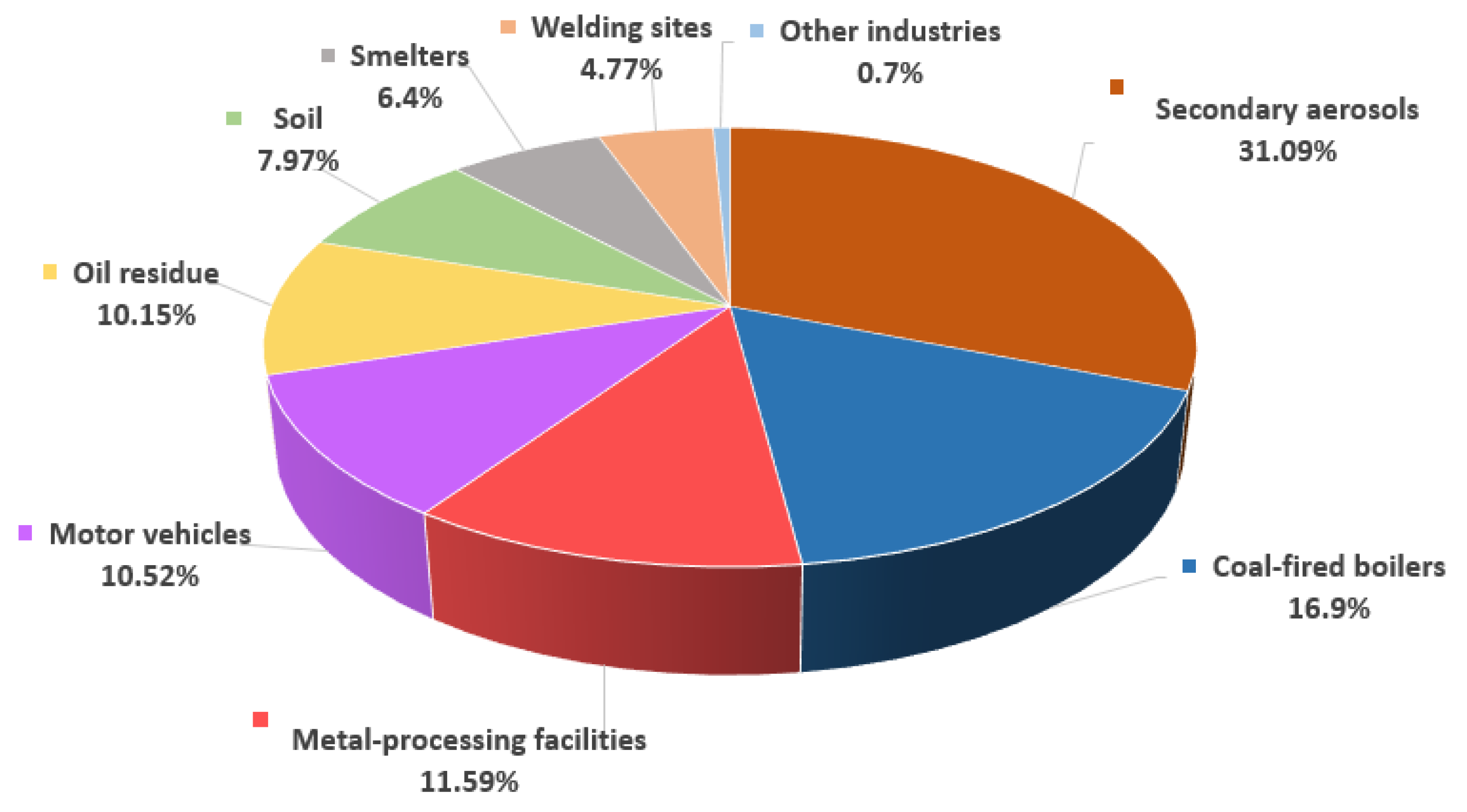

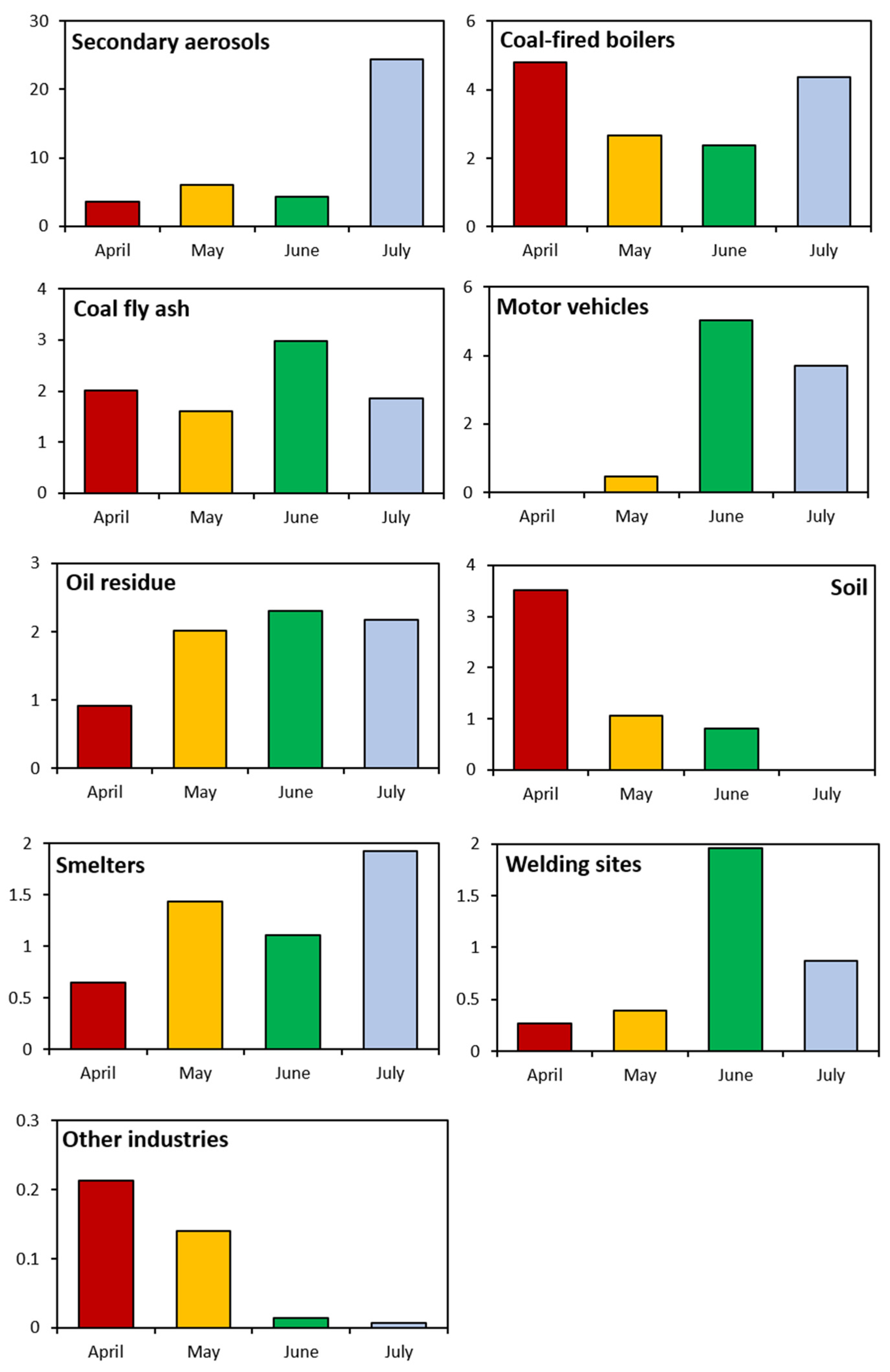

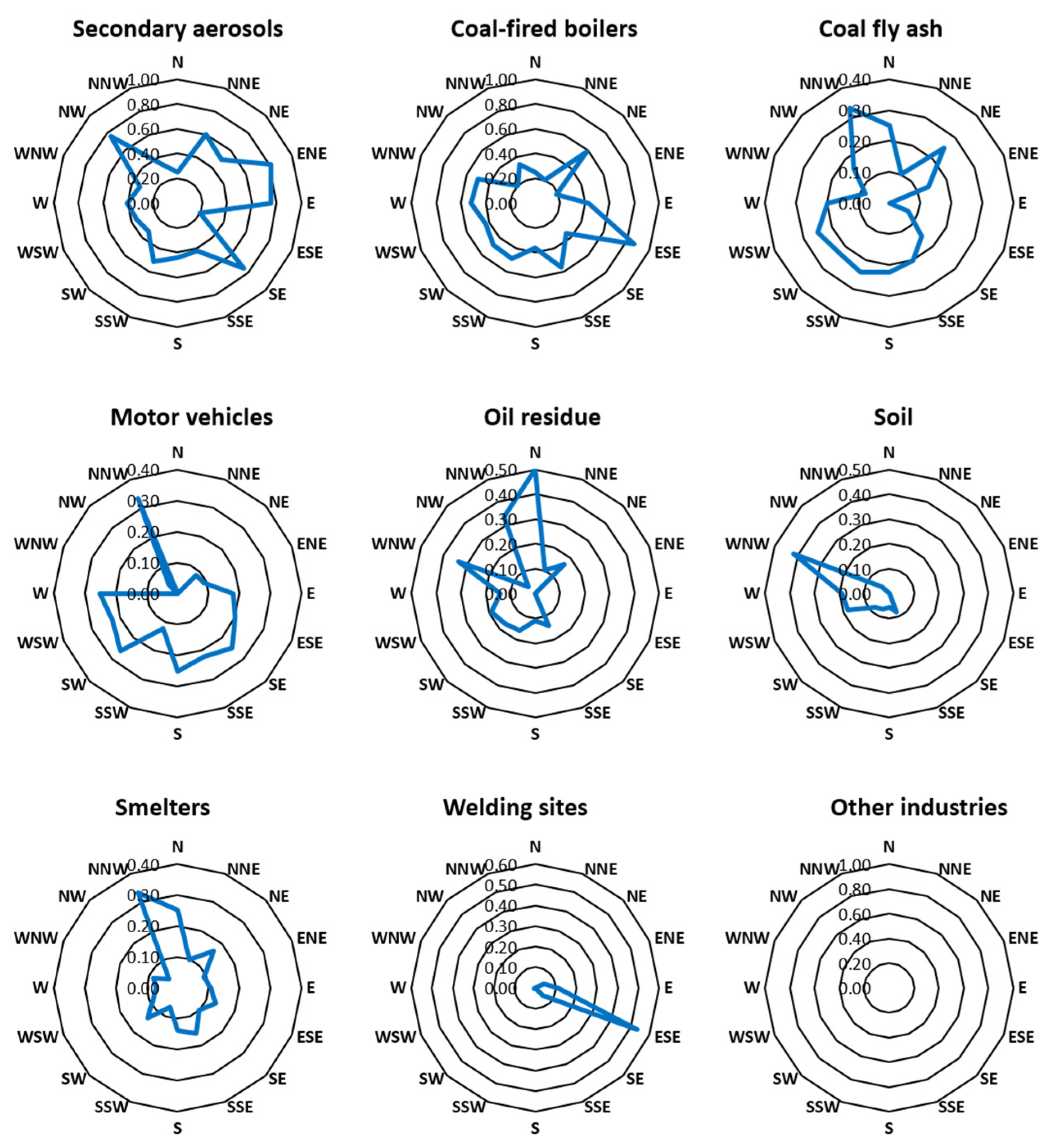
| Administrative District of Bucheon City | Area (km2) | Class 3 | Class 4 | Class 5 | Total |
|---|---|---|---|---|---|
| Simgok-dong | 2.6 | 1 | 4 | 5 | |
| Bucheon-dong | 8.1 | 68 | 196 | 264 | |
| Sinjung-dong | 4.5 | 3 | 6 | 9 | |
| Jung-dong | 1.8 | 1 | 3 | 4 | |
| Sang-dong | 3.6 | 0 | |||
| Daesan-dong | 4.1 | 1 | 1 | 8 | 10 |
| Sosabon-dong | 3.0 | 3 | 5 | 8 | |
| Beom-an-dong | 5.7 | 3 | 3 | ||
| Seong-gok-dong | 7.6 | 2 | 3 | 5 | |
| Ojeong-dong | 12.4 | 1 | 116 | 330 | 447 |
| Total | 53.4 | 2 | 195 | 558 | 755 |
| Species | S/N Ratio (a) DL (b) | Concentration (μg/m3) | ||||
|---|---|---|---|---|---|---|
| Min | 25th | 50th | 75th | Max | ||
| PM2.5 | - - | 0.3066 | 14.5581 | 17.8298 | 22.3221 | 60.7302 |
| Al | 7.5 0.0060 | 0.0030 | 0.1199 | 0.2178 | 0.3749 | 2.2850 |
| Ti | 8.2 0.0004 | 0.0002 | 0.0094 | 0.0139 | 0.0205 | 0.0722 |
| Co | 7.8 0.3761 | 0.0000 | 0.0019 | 0.0044 | 0.0102 | 0.0481 |
| V | 7.0 0.0001 | 0.0001 | 0.0011 | 0.0029 | 0.0047 | 0.0092 |
| Se | 5.5 0.0004 | 0.0002 | 0.0009 | 0.0025 | 0.0043 | 0.0110 |
| As | 7.5 0.0001 | 0.0000 | 0.0017 | 0.0045 | 0.0080 | 0.0284 |
| SiO | 2.8 0.0687 | 0.2172 | 0.2172 | 0.2172 | 2.3837 | 7.8155 |
| Mg | 7.9 0.0075 | 0.0037 | 0.0822 | 0.1579 | 0.2422 | 1.0879 |
| Zn | 9.0 0.0002 | 0.0037 | 0.0440 | 0.0732 | 0.0910 | 0.1295 |
| Br | 8.9 0.0002 | 0.0020 | 0.0113 | 0.0186 | 0.0262 | 0.0519 |
| Ca | 6.7 0.0033 | 0.0017 | 0.0156 | 0.0419 | 0.0661 | 0.5559 |
| Pb | 8.6 0.0003 | 0.0001 | 0.0134 | 0.0207 | 0.0304 | 0.1302 |
| Cr | 8.4 0.0004 | 0.0021 | 0.0048 | 0.0061 | 0.0081 | 0.0339 |
| Mn | 8.1 0.0007 | 0.0003 | 0.0106 | 0.0142 | 0.0199 | 0.1024 |
| Fe | 8.9 0.0011 | 0.0102 | 0.2010 | 0.2625 | 0.3296 | 0.7181 |
| Ni | 6.9 0.0001 | 0.0000 | 0.0005 | 0.0012 | 0.0032 | 0.0211 |
| Na+ | 5.3 0.0403 | 0.0448 | 0.1036 | 0.1480 | 0.2819 | 0.6206 |
| NH4+ | 8.3 0.0311 | 0.0156 | 0.8914 | 1.7629 | 2.9646 | 8.6075 |
| K+ | 3.6 0.0493 | 0.0246 | 0.0246 | 0.1654 | 0.2079 | 0.3672 |
| Cl− | 2.7 0.0983 | 0.0492 | 0.1044 | 0.1873 | 0.2932 | 0.7726 |
| NO3− | 6.4 0.1117 | 0.0559 | 0.4143 | 1.1186 | 2.5808 | 12.7241 |
| SO42− | 3.3 0.1076 | 0.0538 | 0.0842 | 0.2841 | 0.4689 | 1.0071 |
| OC | 6.9 0.1164 | 2.1639 | 6.7140 | 7.9161 | 8.9695 | 13.4190 |
| EC | 7.3 0.0196 | 0.2119 | 1.1001 | 1.2565 | 1.4784 | 2.4926 |
| Source | Weekdays | Weekends |
|---|---|---|
| Secondary aerosols | 4.53 | 7.65 |
| 24.34 | 42.29 | |
| Coal-fired boilers | 2.93 | 3.41 |
| 15.74 | 18.86 | |
| Metal-processing facilities and coal fly ash | 1.92 | 2.49 |
| 10.29 | 13.74 | |
| Motor vehicles | 2.36 | 1.26 |
| 12.66 | 6.94 | |
| Oil combustion residues | 2.11 | 1.49 |
| 11.31 | 8.22 | |
| Soil | 2.16 | 0.36 |
| 11.61 | 1.97 | |
| Smelters | 1.33 | 0.94 |
| 7.13 | 5.18 | |
| Welding sites | 1.20 | 0.36 |
| 6.46 | 1.97 | |
| Other industries | 0.09 | 0.15 |
| 0.47 | 0.82 | |
| Total | 18.63100 | 18.09100 |
| Source | April | May | June | July |
|---|---|---|---|---|
| Secondary aerosols | 3.61 | 6.03 | 4.36 | 24.35 |
| 22.66 | 38.14 | 20.81 | 62.17 | |
| Coal-fired boilers | 4.79 | 2.67 | 2.39 | 4.36 |
| 30.04 | 16.89 | 11.40 | 11.13 | |
| Metal-processing facilities and coal fly ash | 2.00 | 1.60 | 2.98 | 1.86 |
| 12.56 | 10.13 | 14.23 | 4.74 | |
| Motor vehicles | 0.00 | 0.48 | 5.02 | 3.70 |
| 0.00 | 3.04 | 23.98 | 9.46 | |
| Oil combustion residues | 0.91 | 2.01 | 2.30 | 2.18 |
| 5.72 | 12.71 | 11.00 | 5.56 | |
| Soil | 3.52 | 1.05 | 0.81 | 0.00 |
| 22.05 | 6.64 | 3.89 | 0.00 | |
| Smelters | 0.65 | 1.43 | 1.11 | 1.93 |
| 4.06 | 9.05 | 5.29 | 4.92 | |
| Welding sites | 0.26 | 0.40 | 1.95 | 0.87 |
| 1.66 | 2.51 | 9.33 | 2.22 | |
| Other industries | 0.21 | 0.14 | 0.01 | 0.01 |
| 1.33 | 0.88 | 0.07 | 0.02 | |
| Total | 15.95 100 | 15.82 100 | 20.94 100 | 39.16 100 |
Disclaimer/Publisher’s Note: The statements, opinions and data contained in all publications are solely those of the individual author(s) and contributor(s) and not of MDPI and/or the editor(s). MDPI and/or the editor(s) disclaim responsibility for any injury to people or property resulting from any ideas, methods, instructions or products referred to in the content. |
© 2023 by the authors. Licensee MDPI, Basel, Switzerland. This article is an open access article distributed under the terms and conditions of the Creative Commons Attribution (CC BY) license (https://creativecommons.org/licenses/by/4.0/).
Share and Cite
Lee, G.; KIM, M.; Park, D.; Yoo, C. Fine Particulate Matter (PM2.5) Sources and Its Individual Contribution Estimation Using a Positive Matrix Factorization Model. Toxics 2023, 11, 69. https://doi.org/10.3390/toxics11010069
Lee G, KIM M, Park D, Yoo C. Fine Particulate Matter (PM2.5) Sources and Its Individual Contribution Estimation Using a Positive Matrix Factorization Model. Toxics. 2023; 11(1):69. https://doi.org/10.3390/toxics11010069
Chicago/Turabian StyleLee, Gahye, Minkyeong KIM, Duckshin Park, and Changkyoo Yoo. 2023. "Fine Particulate Matter (PM2.5) Sources and Its Individual Contribution Estimation Using a Positive Matrix Factorization Model" Toxics 11, no. 1: 69. https://doi.org/10.3390/toxics11010069







